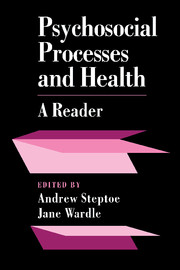Book contents
- Frontmatter
- Contents
- Preface
- Section 1 Life stress, social support and health
- Section 2 Psychophysiological processes in disease
- Section 3 Personality, behaviour patterns and health
- Section 4 Health practices and the modification of health risk behaviour
- Section 5 Coping with illness and disability
- Active coping processes, coping dispositions, and recovery from surgery
- The impact of denial and repressive style on information gain and rehabilitation outcomes in myocardial infarction patients
- Reduction of postoperative pain by encouragement and instruction of patients: a study of doctor-patient rapport
- Psychological response to breast cancer: effect on outcome
- The effects of choice and enhanced personal responsibility for the aged: a field experiment in an institutional setting
- Section 6 Behavioural interventions in medicine
- Index
Reduction of postoperative pain by encouragement and instruction of patients: a study of doctor-patient rapport
from Section 5 - Coping with illness and disability
Published online by Cambridge University Press: 05 August 2016
- Frontmatter
- Contents
- Preface
- Section 1 Life stress, social support and health
- Section 2 Psychophysiological processes in disease
- Section 3 Personality, behaviour patterns and health
- Section 4 Health practices and the modification of health risk behaviour
- Section 5 Coping with illness and disability
- Active coping processes, coping dispositions, and recovery from surgery
- The impact of denial and repressive style on information gain and rehabilitation outcomes in myocardial infarction patients
- Reduction of postoperative pain by encouragement and instruction of patients: a study of doctor-patient rapport
- Psychological response to breast cancer: effect on outcome
- The effects of choice and enhanced personal responsibility for the aged: a field experiment in an institutional setting
- Section 6 Behavioural interventions in medicine
- Index
Summary
Many reports have discussed the treatment of patients suffering after operation. Narcotics are not without danger; they also vary considerably in effectiveness. Hypnosis will reduce pain but is difficult to achieve and requires special training for the operator. Despite considerable effort the problems of treating postoperative pain remain.
Janis has shown that patients who were told about their operations before the procedure remembered the operation and its sequelae more favorably than those who were not well informed. We have determined the effects of instruction, suggestion and encouragement upon the severity of post operative pain.
Method
We studied 97 patients after elective intra-abdominal operations (Table 1). All patients were visited the night before operation by the anesthetist, who told them about the preparation for anesthesia, as well as the time and approximate duration of the operation, and warned them that they would wake up in the recovery room. Preanesthetic medication, consisting of pentobarbital sodium, 2mg. per kilogram of body weight, and atropine, 0.6 mg., was administered intramuscularly approximately one hour before operation. Induction of anesthesia was accomplished with thiopental sodium; intubation of the trachea was performed on all patients. Anesthesia was maintained with ether and cyclopropane or nitrous oxide and curare.
The patients were divided into two groups by random order; 51 patients (control group) were not told about postoperative pain by the anesthetist. The “special-care” group consisted of 46 patients who were told about postoperative pain. They were informed where they would feel pain, how severe it would be and how long it would last and reassured that having pain was normal after abdominal operations. As soon as the patients appeared aware of the nature of the suffering that would begin on the following day, they were told what would be done about the pain. They were advised that pain is caused by spasm of the muscles under the incision and that they could relieve most of the pain themselves by relaxing these muscles. They could achieve relaxation by slowly taking a deep breath and consciously allowing the abdominal wall to relax. Also, they were shown the use of a trapeze that was hanging over the middle of the bed (control patients also had the trapeze but were not instructed by the anesthetist).
- Type
- Chapter
- Information
- Psychosocial Processes and HealthA Reader, pp. 386 - 392Publisher: Cambridge University PressPrint publication year: 1994
- 1
- Cited by



